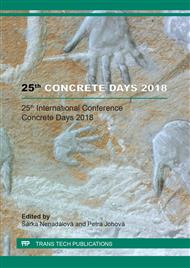p.203
p.210
p.217
p.224
p.230
p.236
p.242
p.249
p.257
Cracking and Failure Mode of the Self-Stressed Members with FRP Bars
Abstract:
Fiber reinforced polymer (FRP) bars represent a combination of the polymer binder and reinforcing fibers (glass, basalt, aramid, carbon). The main features of FRP bars are high tensile strength on the background of the relatively low elasticity modulus. To prevent development of the excessive both crack opening and deflections in the FRP reinforced concrete structures it can be effective to implement FRP reinforcement pretensioning with a limited level of created stresses. As a good option can be considered a physico-chemical method of FRP bars pretensioning based on the self-stressing concrete utilizing. In the self-stressed FRP reinforced members it is possible to obtain a considerable values of the early age restrained expansion strains (in comparison with steel reinforced self-stressed members because of FRP bars lower elasticity modulus), which will not disappear after air-dry shrinkage strains realization. In addition, another concern that have to be considered in the field of FRP reinforced self-stressed members is bond performance of the different FRP bars types, especially in combination with self-stressing concrete that within its expansion can provoke decompacting of the transit zone «bar-concrete». Moreover, taking into account that FRP bars is a composite material, its bond properties are strongly influenced by the types of the polymer binder, reinforcing fibers, ratio between binder and fibers, bar coating. Presented studies is consisted in the experimental investigations of the features in the crack development and depended on it occurred failure mode of the self-stressed members reinforced by the different types of FRP bars.
Info:
Periodical:
Pages:
230-235
Citation:
Online since:
June 2019
Authors:
Price:
Сopyright:
© 2019 Trans Tech Publications Ltd. All Rights Reserved
Share:
Citation:


